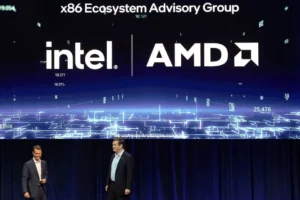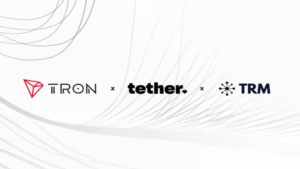Home Laptops Laptops News Intel, AMD Form x86 Ecosystem Advisory Group for Improved Software Compatibility Amidst Increasing Competition From Arm Intel, AMD Form x86 Ecosystem Advisory Group for Improved Software Compatibility Amidst Increasing Competition From Arm
Intel and AMD have joined forces to create the x86 Ecosystem Advisory Group, marking a pivotal moment in the history of computing. This unprecedented partnership aims to shape the future of the x86 architecture, a cornerstone of the computing industry since its invention in the late 1970s. With competition from Cambridge-based Arm intensifying, the advisory group seeks to ensure the longevity and relevance of the x86 ecosystem by fostering collaboration among major industry players.
The formation of the x86 Ecosystem Advisory Group was announced at the OCP Global Summit in California. The collaboration brings together Intel and AMD, two long-standing rivals, along with a diverse group of partners, including Lenovo, Dell, Google, HP, Microsoft, and Meta. The group’s primary goal is to maintain software compatibility across x86 processors, ensuring a seamless experience for developers and users alike. This move addresses a growing need to counter the competitive edge that Arm-based chips offer in terms of cross-platform compatibility.
A Changing Landscape in Computing
For decades, x86 processors have dominated the PC and server markets. Intel’s release of the first x86 processor more than 40 years ago set the stage for widespread adoption across a variety of applications, from personal computers to enterprise-grade servers. However, recent years have seen a dramatic shift in the computing landscape. Arm-based processors, once confined to mobile devices, are now making significant inroads into the PC and server markets.
Apple’s M-series chips and Qualcomm’s Snapdragon X-series have highlighted the potential of Arm-based architectures. These processors deliver impressive performance and power efficiency, making them increasingly attractive to both consumers and businesses. For instance, the release of Qualcomm’s octa-core Snapdragon X Plus in 2024 brought Arm-powered laptops below the $800 price point (roughly ₹67,200), further increasing accessibility.
This shift has led to notable changes in market dynamics. According to Grand View Research, the global market for Arm-based servers was valued at $5.84 billion (roughly ₹49,070 crore) in 2023. The sector is expected to grow at a compound annual growth rate (CAGR) of 14.3% from 2024 to 2030. These trends underscore the urgency for Intel and AMD to innovate and reinforce the x86 ecosystem.
The Importance of Compatibility
One of the key advantages of Arm-based chips lies in their robust compatibility framework. Arm mandates that all chipmakers support its software ecosystem, ensuring that applications run seamlessly across devices from different manufacturers. This standardization has been a significant factor in Arm’s growing popularity.
The x86 Ecosystem Advisory Group aims to replicate this level of compatibility within the x86 architecture. By creating a “more unified set of instructions and architectural interfaces,” the group seeks to simplify software development and ensure consistency across Intel and AMD processors. This initiative will also address fragmentation issues that have historically posed challenges for the x86 platform.
The advisory group’s efforts are not limited to technical improvements. By fostering collaboration among industry leaders, the group aims to build a stronger and more resilient ecosystem. Founding members include tech giants such as Dell, Broadcom, Lenovo, Google, Microsoft, HP, and Red Hat. Influential figures like Linus Torvalds, creator of the Linux kernel, and Tim Sweeney, CEO of Epic Games, have also joined the group, bringing valuable perspectives from the software development community.
A Unified Vision for x86
Intel CEO Pat Gelsinger described the formation of the advisory group as a transformative step for the x86 architecture. “We are on the cusp of one of the most significant shifts in the x86 architecture and ecosystem in decades,” Gelsinger said. “New levels of customization, compatibility, and scalability are needed to meet current and future customer needs.”
AMD Chair and CEO Lisa Su echoed this sentiment, emphasizing the importance of collaboration. “Establishing the x86 Ecosystem Advisory Group will ensure that the x86 architecture continues evolving as the compute platform of choice for both developers and customers,” Su stated.
By pooling resources and expertise, Intel, AMD, and their partners aim to address the challenges posed by a rapidly changing market. The advisory group will work to enhance software compatibility, accelerate the adoption of new features, and ensure that x86 remains competitive across a wide range of applications, from PCs and data centers to cloud computing and edge devices.
The Road Ahead
The success of the x86 Ecosystem Advisory Group will depend on its ability to deliver tangible benefits for both developers and end-users. Enhanced software compatibility is expected to streamline development processes, enabling faster innovation and reducing time-to-market for new products. Additionally, a unified x86 platform could drive greater adoption of emerging technologies such as artificial intelligence, machine learning, and edge computing.
The advisory group’s efforts also have significant implications for the broader tech industry. By ensuring the continued relevance of x86, the initiative could influence the competitive dynamics between x86 and Arm-based architectures. This, in turn, could shape the trajectory of innovation in key sectors such as cloud computing, gaming, and enterprise IT.
A Collaborative Approach
The inclusion of influential figures like Linus Torvalds and Tim Sweeney highlights the advisory group’s commitment to engaging with the broader x86 community. Torvalds, as the creator of Linux, brings a deep understanding of open-source development and its role in advancing technology. Sweeney’s expertise in gaming and graphics underscores the importance of x86 in high-performance applications.
By bringing together a diverse array of stakeholders, the x86 Ecosystem Advisory Group aims to foster a culture of collaboration and innovation. This approach reflects a recognition that the challenges facing the x86 ecosystem require collective action and shared responsibility.
Conclusion
The formation of the x86 Ecosystem Advisory Group marks a bold step forward for Intel, AMD, and their partners. Faced with growing competition from Arm, the group represents a unified effort to strengthen the x86 ecosystem and ensure its continued relevance in a rapidly evolving market. By prioritizing compatibility, collaboration, and innovation, the initiative seeks to build a stronger foundation for the future of x86 computing.
If successful, the advisory group could usher in a new era of x86 development, characterized by greater compatibility, faster innovation, and broader adoption of cutting-edge technologies. As the computing landscape continues to evolve, the x86 Ecosystem Advisory Group’s work will play a crucial role in shaping the next chapter of this iconic architecture.











Post Comment